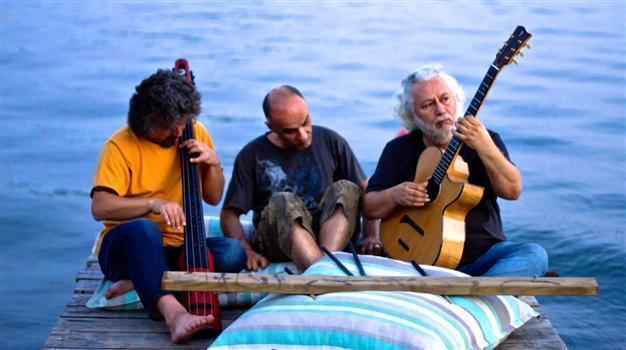Documentary looks at a legend’s trio
Emrah Güler ANKARA - Hürriyet Daily News
 In classical Sufism, or Tasavvuf, the word telvin means a seeker’s quest to journey from one state of being to another. And if you begin the word with a capital letter, it becomes a musical trio from Turkey whose music is inspired by the literal meaning of the word.
In classical Sufism, or Tasavvuf, the word telvin means a seeker’s quest to journey from one state of being to another. And if you begin the word with a capital letter, it becomes a musical trio from Turkey whose music is inspired by the literal meaning of the word.Erkan Oğur is a musical legend in Turkey and around the world. He is the inventor of the first fretless classical guitar and is a master of kopuz and bağlama lutes. A virtuoso at reinventing Turkish folk music, Oğur is also one of the members of the Telvin trio, along with İlkin Deniz and Turgut Alp Bekoğlu.
Much like the transcendent journey the word refers to, Telvin’s music embodies a free-flowing style, blending Turkish folk music with improvisational jazz, refusing structured performances and predefined mechanics in making music. A new documentary, available with English subtitles on DVD, brings to light the inspirations behind their music, the unconventional working dynamics of the members, and how nature is a guiding light in their work.
The documentary “Telvin” is at once an unconventional tour video and an inspirational tribute by a devoted fan. The young director is Okan Avcı, familiar to some thanks to his roles in TV series (“Leyla ile Mecnun” – Leyla and Mecnun) and movies (“Nefes” – Breath), and to others with his award-winning documentary of 2011, “Kadim” (Venerable).
A music constantly in flux
“Kadim,” a look at Turkey’s recent history through a portrait of Avcı’s own grandmother, won the best debut documentary award last year at Turkey’s prestigious Golden Orange Film Festival before going on to win five more honors. Avcı recently starred alongside Kirsten Dunst and Viggo Mortensen in director Hossein Amini’s adaptation of the Patricia Highsmith novel, “The Two Faces of January.”
The Hürriyet Daily News talked to Avcı about his second documentary, “Telvin.” Avcı first heard of the trio when he was a young boy, soon after the group was founded in 1995. “I remember listening to it in the silence of the night and how I had enjoyed it,” he said. “I was new to jazz or Anatolian blues at the time.”

‘I remember listening to the trio
in the silence of the night and
how I had enjoyed it,’ says Okan
Avcı, director of the
documentary ‘Telvin.’
Oğur is known for keeping his distance from the media, preferring to communicate solely through his music. How, then, did Avcı convince Oğur and his bandmates to become part of a documentary? Avcı had already worked with Oğur when he composed the score to “Kadim.”
“I had listened to Telvin for a long time. And when I decided to become a filmmaker, Telvin was very important to me at that place in my life,” said Avcı. “Telvin’s quest to find harmony through a music constantly in flux, in response to a life constantly in flux, felt very close to home at that time. It felt close to the stories I wanted to tell.”
Taking risks on stage (and on film)
Avcı and his team of three, Serkan Yüksel, Özgül Özgüle and Burcu İpek, followed Telvin as they performed in Istanbul and along the coast of Turkey for one month. “It was a small team, actually,” said Avcı. “It was my choice to work with a small team, to be close to them. We just wanted to be with them quietly.”
The film crew just shot concert footage for the first 10 days. “We began the interviews when our crew started becoming close to them,” he said. “I wanted to capture Telvin’s music visually in nature.”
The film begins in an underwater cave, while most of the interviews take place against the backdrop of the Aegean Sea. Intermingling with concert footage and interviews, you see visuals of the sea, a forest, and water flowing from a spring. “Harmony is in nature. We have to stop and just look at it.
Telvin is trying to find that harmony through their music,” said Avcı.
“Theirs is a difficult music,” admits Avcı. “They go out of the preconceived notions of music, they create chaos on stage, and find harmony in that chaos. You have to be in total control of something before breaking it into pieces, to reconstruct it as something different. They do this through respecting nature, listening to one another and talking to one another during rehearsals. It’s a breath of fresh air in contemporary music designed for quick consumption.”
The film shows the trio taking risks on the stage,” said Avcı, admitting also to the risk he is taking as a filmmaker in trying to capture the essence of Telvin.
As Deniz says in the documentary, “Trying to understand music brings with it enjoyment from music. So when someone from the audience says, ‘We didn’t understand anything in your music, but we loved it,’ it shows that they are trying to understand the music they are listening to.”
“So the documentary is taking a risk as it tries to talk about Telvin,” said Avcı.
















